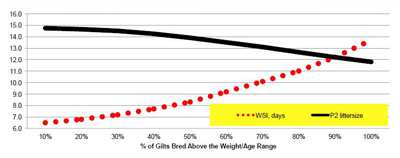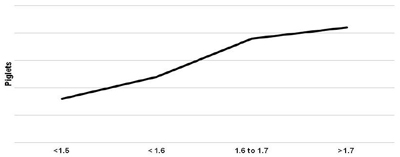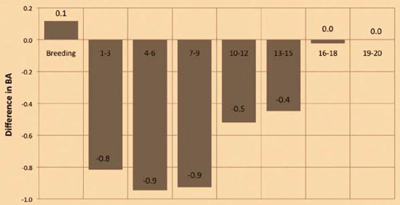
It apparently does take two to tango
 By Jessica Boehm More than 300 producers attended the Midwest Pork Conference in Danville, Indiana last week. This is a one-day conference focused on the topics that matter to the livelihood of hog producers. It inspired pork producers to keep up the good work as well as provided suggestions to further improve their production to keep feeding the world. I found one topic particularly interesting. Dr. Jose Piva of PIC discussed “Improving farrow rate and litter size on your farm to impact the bottom line.” Gilt management According to Piva, the following characteristics “set up replacement gilts for success.” (The number of stars represents the importance of her success in the herd.)
By Jessica Boehm More than 300 producers attended the Midwest Pork Conference in Danville, Indiana last week. This is a one-day conference focused on the topics that matter to the livelihood of hog producers. It inspired pork producers to keep up the good work as well as provided suggestions to further improve their production to keep feeding the world. I found one topic particularly interesting. Dr. Jose Piva of PIC discussed “Improving farrow rate and litter size on your farm to impact the bottom line.” Gilt management According to Piva, the following characteristics “set up replacement gilts for success.” (The number of stars represents the importance of her success in the herd.)
- Minimum of a 300- to 320-pound gilt*****
- Average daily gain (ADG) of 1.4 to 1.6 pounds per day from birth to breeding***** (if her ADG was less than 1.3, reproductive performance was shown to be limited)
- Immunity status: Need three weeks from date of last vaccine prior to breeding*****
- Need maximum feed intake prior to first breeding (with a minimum of 8 pounds per day)*****
- 200 to 210 days of age at the second heat and first breeding***
Gilt weight Piva said a good rule of thumb is for a minimum of 70 percent of the gilts to be bred within the 300-to-320-pound weight range. If gilts get out of this range, they will cost you more in the barn for feeding. Additionally, data shows they will have a longer wean to service interval (WSI) by 0.7 days and a lower reproductive performance of -0.3 pigs once they become a P2, as depicted in the graph below. Figure 1. Effect of >240-day-old gilts on subsequent WSI length and P2 litter size (as shared by Piva 12.4.12)  Gilt ADG The ADG of the gilt is important relative to the number of piglets she will produce. It appears ADG plateaus at about 1.7 from birth to breeding (see figure 2). A gilt with an ADG of 1.38 from birth to breeding will produced 31 piglets; a gilt with an ADG of 1.7 produced 33 piglets. Figure 2. Effect of gilts ADG (lb/day birth to breeding) on P1 litter size (Source: Gonzalo Castro; as shared by Piva 12.4.12)
Gilt ADG The ADG of the gilt is important relative to the number of piglets she will produce. It appears ADG plateaus at about 1.7 from birth to breeding (see figure 2). A gilt with an ADG of 1.38 from birth to breeding will produced 31 piglets; a gilt with an ADG of 1.7 produced 33 piglets. Figure 2. Effect of gilts ADG (lb/day birth to breeding) on P1 litter size (Source: Gonzalo Castro; as shared by Piva 12.4.12)  Timing of breeding The timing of breeding is important due to the stress that can occur in moving from pens to stalls. Piva suggests breeding on day 0 or 16 if the gilts are placed into stalls. The data suggests that if you breed the animal when she has been in the crate during this time range, she will deliver fewer pigs (as shown in Figure 3 below). Figure 3. Differences in litter size in P1 according to gilt stall length (days) (as shared by Piva 12.4.12)
Timing of breeding The timing of breeding is important due to the stress that can occur in moving from pens to stalls. Piva suggests breeding on day 0 or 16 if the gilts are placed into stalls. The data suggests that if you breed the animal when she has been in the crate during this time range, she will deliver fewer pigs (as shown in Figure 3 below). Figure 3. Differences in litter size in P1 according to gilt stall length (days) (as shared by Piva 12.4.12)  Boar influence With all that focus on gilts, we can’t forget the all-important influence of the boar. The exposure of gilts to boars is critical to trigger the estrus cycle. Piva suggests that, at 24- to 25-weeks-old, gilts need boar exposure seven days a week. Otherwise, you could potentially miss 25 percent of the animals. Being just as picky with the boar as you are with replacement gilts will get you the best results. Here are some suggestions for the boar you use:
Boar influence With all that focus on gilts, we can’t forget the all-important influence of the boar. The exposure of gilts to boars is critical to trigger the estrus cycle. Piva suggests that, at 24- to 25-weeks-old, gilts need boar exposure seven days a week. Otherwise, you could potentially miss 25 percent of the animals. Being just as picky with the boar as you are with replacement gilts will get you the best results. Here are some suggestions for the boar you use:
- Boar must be 11 months of age
- Need one boar per 100 gilts
- Don’t work the boar for more than one hour per day
- Annual replacement is 30 percent per year for boars
- Dedicate 20 to 30 seconds of boar exposure per open gilt per day
This is just the beginning of ideas you can use to improve your bottom line. Contact your Vita Plus consultant to brainstorm strategies that best fit your operation. About the author: Jessica Boehm previously worked as the Vita Plus swine technical information specialist. She attended the University of Wisconsin-Stevens Point and earned a bachelor’s degree with a major in biology and minor in chemistry and psychology in 2006. She earned her master’s degree in swine nutrition at UW-Madison in 2009. She was raised in southern Wisconsin and spent her time on the family farm, raising veal, sheep, steers, pigs and tobacco. Boehm is active in her community and on the family farm, and enjoys outdoor activities and spending time with her husband, Justin.
| Category: |
Reproduction and genetics Swine Performance |

